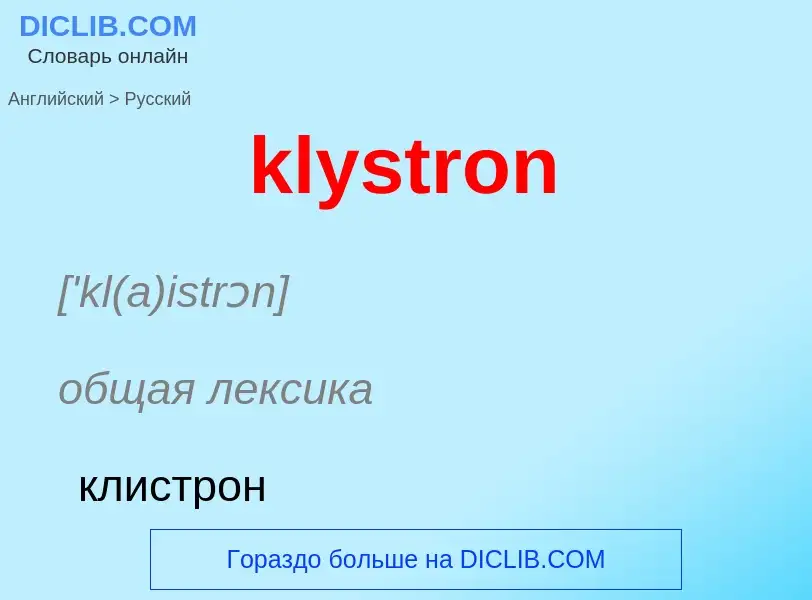Translation and analysis of words by ChatGPT artificial intelligence
On this page you can get a detailed analysis of a word or phrase, produced by the best artificial intelligence technology to date:
- how the word is used
- frequency of use
- it is used more often in oral or written speech
- word translation options
- usage examples (several phrases with translation)
- etymology
klystron - translation to russian
['kl(a)istrɔn]
общая лексика
клистрон
клистронный
существительное
электроника
клистрон
общая лексика
отражательный клистрон
Definition
Wikipedia

A klystron is a specialized linear-beam vacuum tube, invented in 1937 by American electrical engineers Russell and Sigurd Varian, which is used as an amplifier for high radio frequencies, from UHF up into the microwave range. Low-power klystrons are used as oscillators in terrestrial microwave relay communications links, while high-power klystrons are used as output tubes in UHF television transmitters, satellite communication, radar transmitters, and to generate the drive power for modern particle accelerators.
In a klystron, an electron beam interacts with radio waves as it passes through resonant cavities, metal boxes along the length of a tube. The electron beam first passes through a cavity to which the input signal is applied. The energy of the electron beam amplifies the signal, and the amplified signal is taken from a cavity at the other end of the tube. The output signal can be coupled back into the input cavity to make an electronic oscillator to generate radio waves. The gain of klystrons can be high, 60 dB (an increase in signal power by a factor of one million) or more, with output power up to tens of megawatts, but the bandwidth is narrow, usually a few percent although it can be up to 10% in some devices.
A reflex klystron is an obsolete type in which the electron beam was reflected back along its path by a high potential electrode, used as an oscillator.
The name klystron comes from the Greek verb κλύζω (klyzo) referring to the action of waves breaking against a shore, and the suffix -τρον ("tron") meaning the place where the action happens. The name "klystron" was suggested by Hermann Fränkel, a professor in the classics department at Stanford University when the klystron was under development.


![Large klystrons as used in the [[storage ring]] of the [[Australian Synchrotron]] to maintain the energy of the [[electron]] beam Large klystrons as used in the [[storage ring]] of the [[Australian Synchrotron]] to maintain the energy of the [[electron]] beam](https://commons.wikimedia.org/wiki/Special:FilePath/Aust.-Synchrotron,-Klystron-for-Storage-Ring,-14.06.2007.jpg?width=200)
![Low-power Soviet reflex klystron from 1963. The [[cavity resonator]] from which the output is taken, is attached to the electrodes labeled ''Externer Resonator''. Reflex klystrons are almost obsolete now. Low-power Soviet reflex klystron from 1963. The [[cavity resonator]] from which the output is taken, is attached to the electrodes labeled ''Externer Resonator''. Reflex klystrons are almost obsolete now.](https://commons.wikimedia.org/wiki/Special:FilePath/ExKlystron.jpg?width=200)

![Klystron oscillator from 1944. The electron gun is on the right, the collector on the left. The two [[cavity resonator]]s are in center, linked by a short coaxial cable to provide positive feedback. Klystron oscillator from 1944. The electron gun is on the right, the collector on the left. The two [[cavity resonator]]s are in center, linked by a short coaxial cable to provide positive feedback.](https://commons.wikimedia.org/wiki/Special:FilePath/Klystron oscillator 1944.jpg?width=200)



